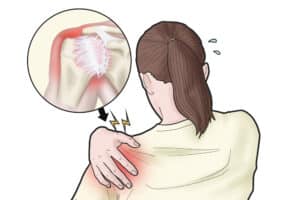Muscle Imbalances
What is Muscle Imbalance?
Muscle imbalance can be described as an inequality in the distribution of forces between the agonist and antagonist muscles of a joint. In other words, muscles acting in one direction on a joint are pulling harder than muscles acting on the joint in the opposite direction. This can negatively affect how the joint functions.
How Does a Muscle Imbalance Occur?
There are several ways in which the force ratios between agonist and antagonist muscles can be disrupted and result in a muscle imbalance, including the following:
- Poor posture
- Eg. prolonged periods of being hunched over a computer
- Improper training
- Eg. too much emphasis on training agonist muscles over antagonist muscles
- Injury/disease
- Eg. tennis elbow, muscle sprains, multiple sclerosis, stroke

Forward head posture and forward rounded shoulders are very common examples of poor postural habits. These can largely be attributed to increasingly sedentary lifestyles that many people are adopting in our society. It comes down to the simple fact that many of us will spend hours each day in front of a computer, TV, textbook, cellphone, tablet, steering wheel, and many other objects and tasks in which we often can find ourselves slumping into very forward rounded positions.
Eventually, poor postural habits like this can lead to a muscle imbalance because the agonist muscles that are consistently being shortened will begin to maladapt to the position by tightening, whereas the antagonist muscles will begin to weaken from frequently being underused and in a lengthened state. These negative muscular changes brought on by poor postural habits then result in a forward rounded position that is maintained even when not engaging in these activities that reinforce it. The following are some of the muscles and muscle groups that would be affected in this example:
- Agonists
- Eg. tightening of pectoralis major and minor, upper trapezius, levator scapula
- Antagonists
- Eg. weakening of middle and lower trapezius, rhomboids, deep cervical flexors
How Does a Muscle Imbalance Cause Pain and Dysfunction?
Whether it was poor posture that led to the muscle imbalance or not, it will likely become the result if the issue is not addressed (again, due to the gradually worsening pull of the joint in one direction). A progressive decrease in mobility and flexibility can eventually take form, as some movements will be limited by muscle weakness, while others will be limited by muscle tightness.
To give a more detailed example: in our case of forward head posture, one major issue is that every inch that the head sits forward from its normal, neutral position, it feels ten pounds heavier. Of course, this means that there is a significant amount of extra work being put on the structures of the neck that support the head. Not only can this result in irritation for the neck muscles and other structures that are working excessively hard, but it also greatly increases the risk for more serious issues in the future, such as degenerative disc disease.
How Do You Fix a Muscle Imbalance?
Assuming your muscle imbalance has arisen from poor postural habits, improper training, or an injury that has since been resolved, the fix involves reversing the problems that have led to it. Muscles that have tightened up need to be stretched, and muscles that have weakened need to be strengthened. At the same time, good postural habits need to be re-established. If the imbalance is a result of improper training at the gym, an additional recommendation would be to develop a new routine that includes a good distribution of exercises across all muscle groups once the imbalance has been resolved.
Of course, some of these suggestions might be easier said than done, especially if a lack of mobility or an excess of pain is inhibiting you from performing certain exercises or stretches that you think might help. Fortunately, there are many professionals that can assist with restoring mobility, managing pain, developing workout programs, and providing education on posture and exercise. Don’t be afraid to seek assistance from a physician, kinesiologist, physiotherapist, chiropractor, or any of several other kinesiology and health professionals.
Finally, consider visiting some of our other blogs for more information on related topics that may be helpful in fixing (or preventing) a muscle imbalance:
- Neutral Spine – https://nova-physiotherapy.com/neutral-spine/
- Posture – https://nova-physiotherapy.com/posture-and-postural-cues/
- Pain Cycle – https://nova-physiotherapy.com/pain-cycle/
Note: if your imbalance is the result of a serious disease or a more severe, on-going injury, the fix may not be as simple. Seek advice from a physician and see if the prior suggestions can benefit you.
References
http://www.muscleimbalancesyndromes.com/janda-syndromes/upper-crossed-syndrome/
https://www.mensfitness.com/training/pro-tips/4-ways-correct-muscle-imbalances







